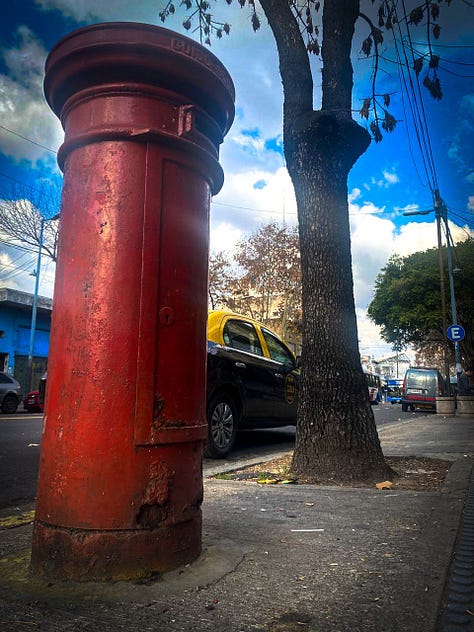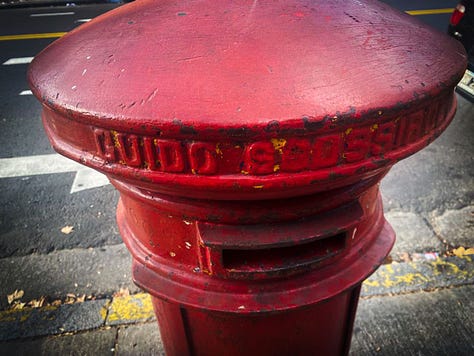Two weeks ago I told you that down here in Buenos Aires we were rounding the corner into winter. It seems I may have lied: what came instead is something called the veranito de San Juan, which is bringing us beautiful spring- and even summer-like days. It often seems that things here are not exactly what they seem. In this case, this non-winter or “miniature summer” is a phenomenon which occurs in Central and South America and is named after its proximity to the feast of St. John. And I don’t know if that’s the reason but everybody’s sick with a terrible cold, which some are saying is avian flu. Of course I caught it and had to miss one of my first choir concerts of the season. Have I mentioned that I sing in choirs? It’s pretty much the closest thing a guitarist can experience to being in an orchestra, if you ask me, and a way to come into contact with the Mozart Requiem and other masterpieces.
Speaking of the Maestro from Salzburg, he came up in conversations recently: earlier this year I wrote a viola sonata for the young violist Fernando Penayo who is from Formosa, a province in the far north of Argentina. He came to Buenos Aires to pursue a career, and when we met to talk about a new piece he told me that he comes from a place where there is very little in terms of the arts, or anything else really. He got into music because of a youth orchestra program and told me that at age 11 he fell in love with Mozart and knew he wanted to be a musician. Music turned out to be his ticket to a different kind of life: he now has a full schedule performing and traveling, and makes time every year to return to Formosa to give concerts and coach aspiring players. I know he’s hoping to change lives, just as music changed his, and just as youth orchestras and arts programs do all over the world.



While the viola sonata was being played up north, I was walking around the neighborhood one day and snapped a photo of a red, metallic pillar I’ve probably walked past 300 times without noticing. It’s a classic Buenos Aires buzón, or mailbox, one of hundreds of out-of-comission metal tubes strewn about the city, filled up with trash, a classic feature of the landscape and a huge part of tango lore right beneath our noses.
Argentina’s mailboxes were originally imported from England, and look like the ones in London. The iconic buzón, like the streetlamp and the elegant gangster, appears in tango after tango, part of the music’s mythic scenery. The classic meeting point in tangos (and in Buenos Aires) is on the corner, and that’s where these mailboxes tend to be. So buzón can refer to a person who hangs out on the corner. Makes sense, right? But it can also mean: blabbermouth, jail cell, latrine, or a passive sexual partner. The object itself is like a pillar with a gaping slot which doesn’t close, so I can see the logic in each of these. A similar word in lunfardo (classic tango slang) also means informant or tattletale: buchón. Sound familiar? It’s a derivation from the French word for mailbox.
🤓 But I’m not here to recite the dictionary! I mean, I could tell you that buzón also means: an intermediary between a drug dealer and customer; a bookie’s employee; someone who stocks arms for illegal militias. But none of that is as good as the following phrase. Repeat it to any Argentine and they will probably laugh, because everyone says it: te vendieron un buzón. Literally “you’ve been sold a mailbox.”
The story behind this saying is fantastic. It refers to a con which was practiced in Buenos Aires in the early 20th century and which targeted immigrants and recent arrivals from the provinces. The scam required two grifters: one would station himself next to a mailbox and the other would walk up with a letter, presenting a payment in order to mail it. When a curious victim would approach the “owner” of the mailbox to inquire about this seemingly lucrative enterprise, the grifter would explain that in fact he owned several mailboxes in the area and was having trouble attending to all of them. “In fact,” he would say, “this one happens to be for sale.” Nowadays in Buenos Aires, whenever you want to tell someone they’ve been stiffed, you can say: “you’ve been sold a mailbox.”
Switching gears from old-time fraud to current psychology, here’s a concept I just learned and which I’ll share with you because I find it fascinating. Have you heard of “System 1 and System 2 thinking?” I was listening to the excellent podcast Hidden Brain, an episode about “trying too hard” and the guest brought it up. In essence: System 1 thinking involves processes which happen unconsciously and automatically: you stand up and walk, or eat with a fork. System 2 is all about what must be done consciously: reading and processing new information, looking up an address and planning how to get there from your location. System 1 uses very little cognitive power, and is fast. System two is slow and draining, using tons of cognitive power.
I love this crisp, clean concept! I naturally applied it to learning and performing music: use system 2 to learn, drill, and internalize the information; use system 1 to perform it effortlessly. I think you’ll find it useful too, because I believe the concept is applicable to many other areas: sports, medicine, relationships, and more. Agree? Disagree? Effort or no effort? Let me know in the comments.
♫♪𝄞⨾𓍢ִ໋ of the week
Terrazas - La Runfla
Here’s a contemporary tango which just came out by the guitar and voice group La Runfla. In all transparency, I had a hand in the song’s creation: In 2022 I produced the album “Veni que te cuento,” which features new music by contemporary women tango singers and this was one of the songs to come out of the project. It’s about three women coming together at night to make music on a rooftop terrace. Three women and no one else, an image which would have been unthinkable in the old days of tango. Here’s a new version La Runfla has just recorded for their new album.
Tema Otoñal (Francini) - Sexteto Mayor
I love listening to this piece any time of year, but what better time than at the end of fall? The title means “Autumnal Song.” This version is by Sexteto Mayor, one of the greatest classic tango sextets of all time. The arrangement is lush, romantic, balanced and in my opinion absolutely perfect.
If it’s Magic - Stevie Wonder
His masterpiece double album “Songs in the Key of Life” needs no introduction, and just about any track from it is a work of art. This one in particular has always seemed special to me: Stevie’s voice accompanied by a solo harp, in what sounds like a plea for humanity to return to what’s most important: love. “For there’s enough for everyone.”
Before I go, I want to remind you to keep an eye on my YouTube channel (and please subscribe!). I’m currently shooting a few different video series on composition, tango, guitar, and more. You’ll find new videos just about every week.




